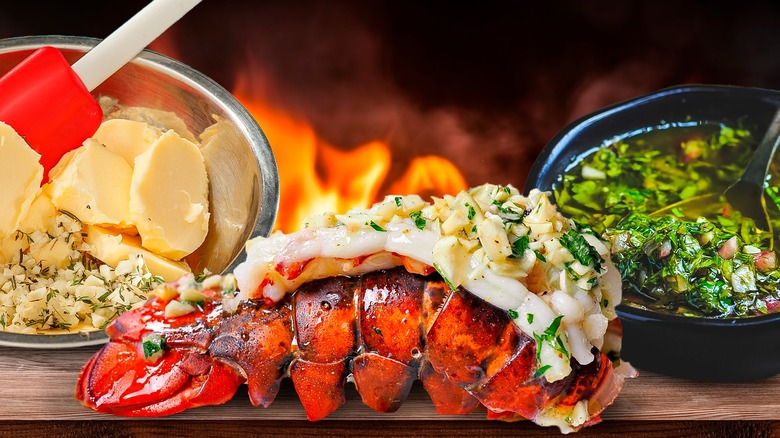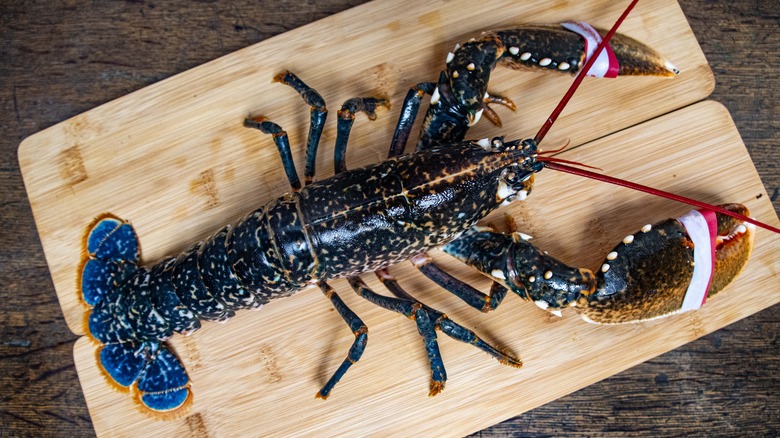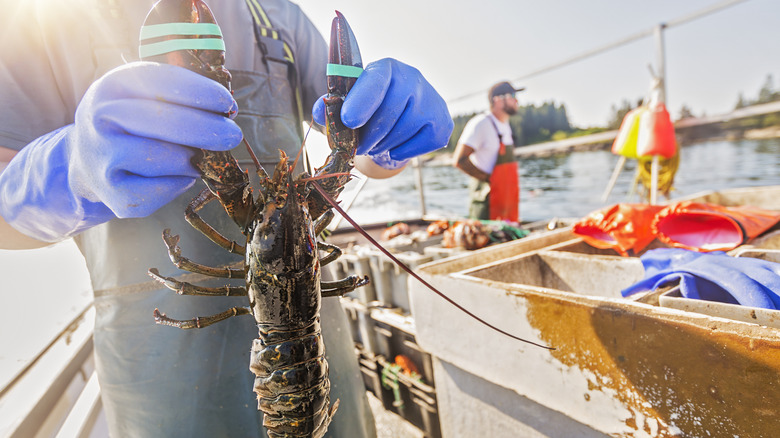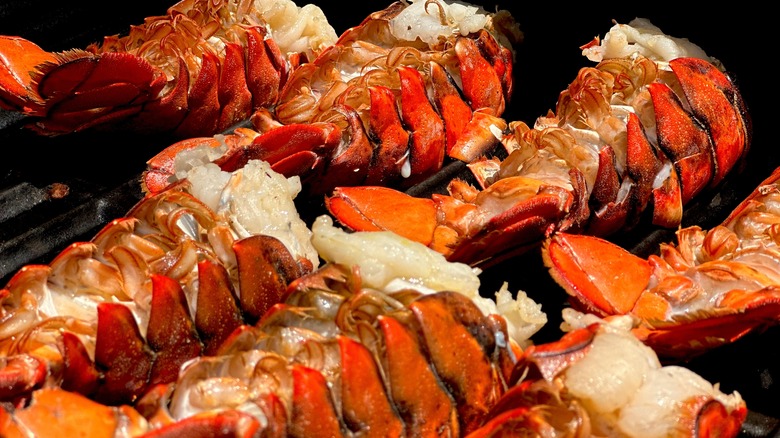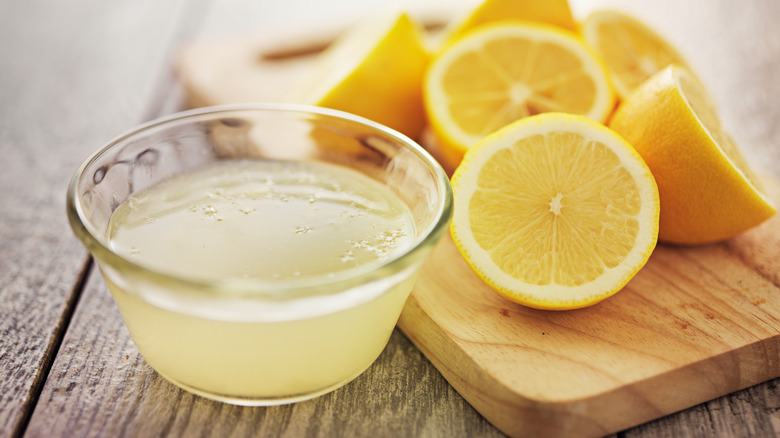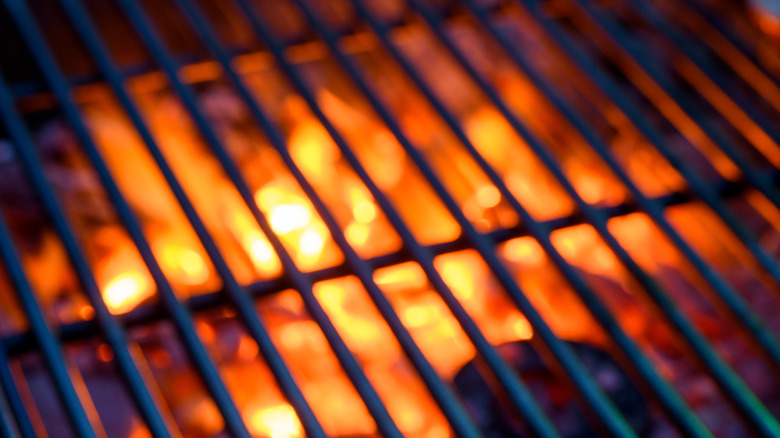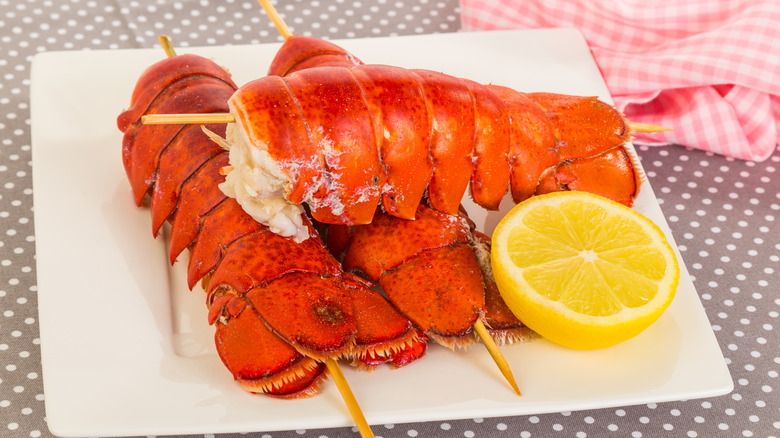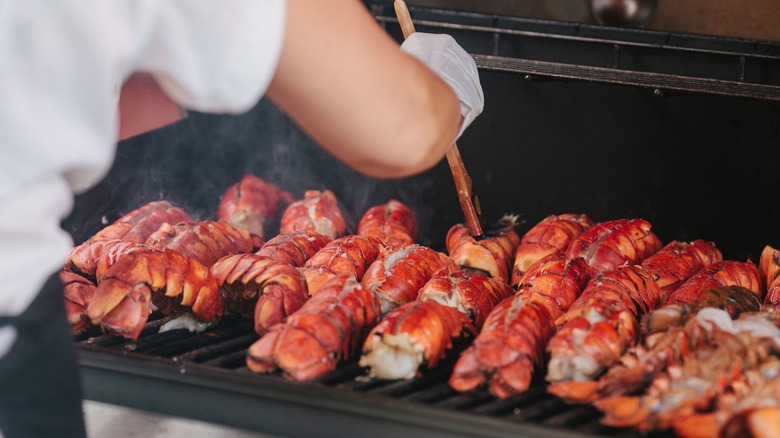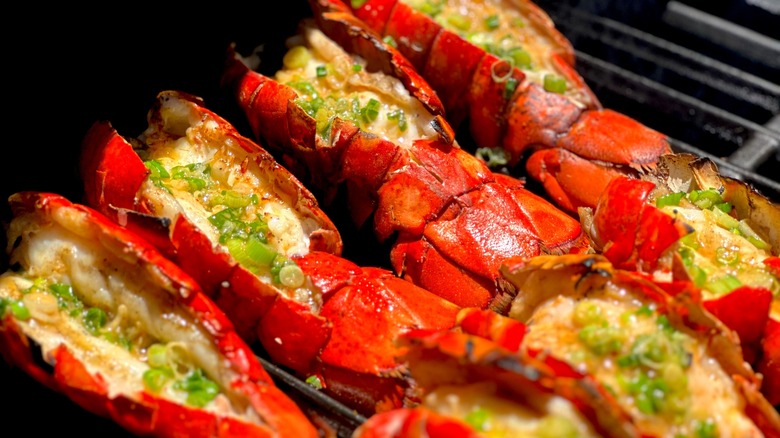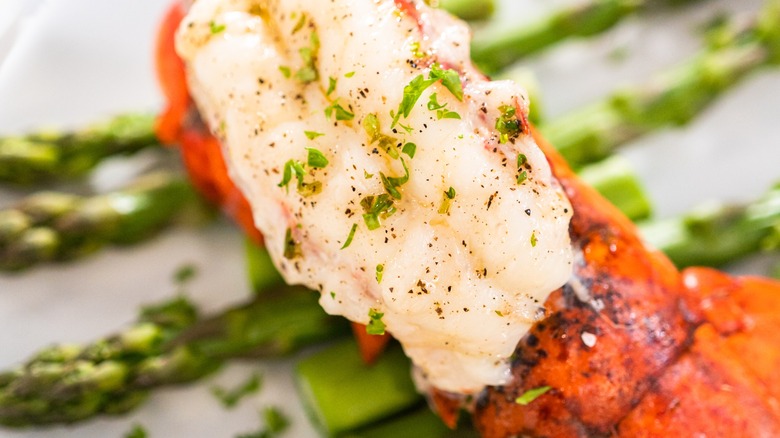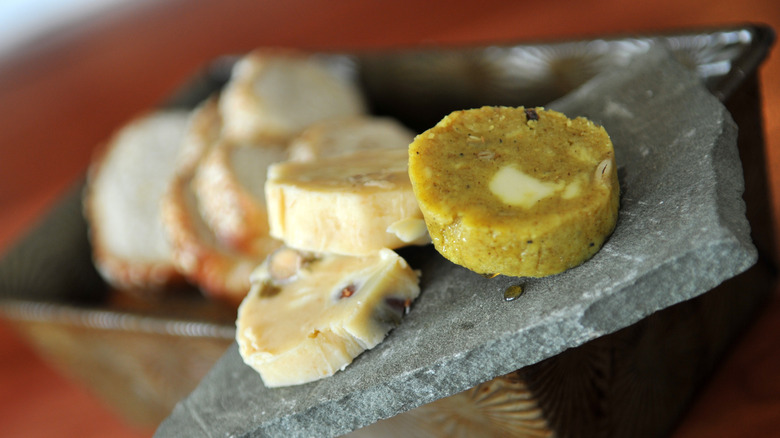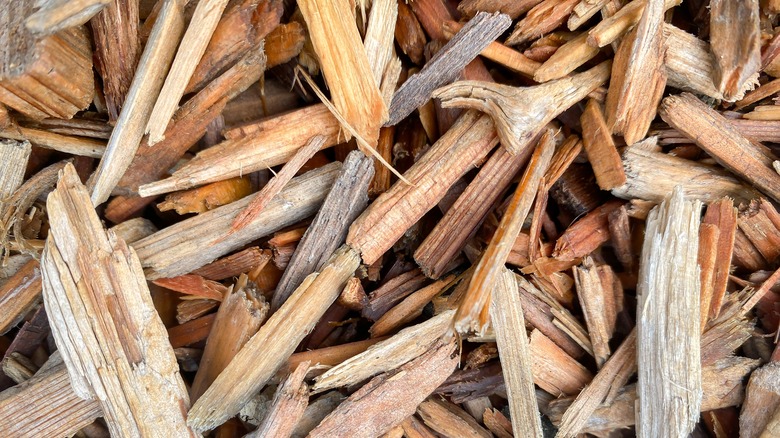12 Tips For Grilling Lobster Tails To Perfection
Lights, camera, grill! If you want to give your summer barbecue a little bit more of a sophisticated flair, you're going to want to leave those burgers in the freezer and skip the hot dogs — go for lobster tails instead. Surely, lobster tails do come with a premium price tag, but they're the perfect way to make your barbecue a bit more memorable and tasty.
While there are other ways to cook meaty lobster tails, including poaching, sous vide, and steaming, grilling will give your seafood the color and flavor that it deserves. We've consulted several different lobster experts, including recipe developer Maya Krampf from Wholesome Yum, recipe developer Nicole Johnson from Or Whatever You Do, and chef and owner of La Riv, Vira Chudasma, on how to properly prepare, grill, and serve lobster tails. With a bit of their insight, you'll be well on your way to serving up succulent and perfectly cooked lobster tails that will surely wow all of your dinner guests.
Know what type of lobster you're purchasing
There are many different types of lobster out there — and some of them are have better tails than others. If you order a lobster tail at a restaurant or try to pick up a whole one from your local grocery, you're likely getting your hands on an American lobster — also called the Maine lobster. Their shells (and tails) can hold a lot of meat, which makes them an ideal option for grilling.
If you live in the southern region of the U.S., though, you may want to try getting your hands on a Florida spiny lobster (aka a Caribbean lobster). The flesh isn't as delicate as this lobster's northern cousin, and it lacks front claws — which means it carries a ton of meat in its tail and carapace. They're also excellent for grilling, but it's important to note that they won't have the same sweet flavor as the American lobster.
And if you're purchasing frozen lobster tail from the grocery store, you may only have one option to choose from: the South African lobster. The tail isn't as sizable as the Florida spiny lobster, but the flesh is rather steak-like and sturdy, which makes it a shoo-in for your grilling adventures.
Choose a high-quality tail
The key to cooking anything successfully is to always start with high-quality ingredients. When looking for lobster, our experts note that you should always opt for the freshest stuff that you can find. Depending on where you live, that might mean taking a walk down to your local fishmonger or visiting the seafood counter at your local grocery store. Granted, the latter will be the go-to option for many folks who live far from where lobsters crawl across the seafloor. "You will have a better luck getting fresh if you go to the fish counter and ask the guys who work behind the fish counter," says chef Vira Chudasma.
"As long as you buy them from a reputable source, the quality shouldn't suffer," says recipe developer Nicole Johnson. She goes on to explain that she does purchase frozen lobster tails and notes that much of the "fresh" tails found in the seafood case are just pre-frozen and thawed before they're sold to you. "Why not eliminate that step and be sure you can eat them when you prefer and not according to the seafood department's calendar?"
Don't butterfly the bottom shell of your lobster
Butterflying is an important technique for grilling. Recipe developer Maya Krampf shares that it's important, though, not to get too excited when it comes to slicing and cutting up your lobster tails to prepare them for the grill. She recommends that folks stick to slicing the top shell and some of the meat, but leaving the bottom shell intact. "The shell protects the delicate flesh when cooking on the second side and prevents the butter from dripping down into the grill after flipping," she says.
To master butterflying your lobster tail, be sure to take it easy and avoid mangling it. Grab a pair of sharp kitchen shears and slice through the top layer. This will give you a little wiggle room to pull the meat out of the shell and expose it to the heat. You'll also want to gently pinch the top shell back together to protect the meat from falling back into the shell.
Skip the acid in your marinade
It isn't uncommon for people to make a marinade for their proteins, especially tough cuts of steak, lamb, and chicken. The purpose of a marinade is to not only imbue the protein fibers with flavor, but also to tenderize it. But when you're working with a delicate protein, like lobster, you have to be rather careful. Lobster is far more fragile than these tougher proteins, so using the wrong combination of ingredients, or letting the seafood sit in it for too long, can cause it to turn to mush.
The one ingredient you'll want to avoid adding to your lobster marinade, per Vira Chudasma, is anything with acid in it, like lemon juice or vinegar. She explains that the acid will essentially cook the meat before it has a chance to hit the grill. If you've ever tried your hand at homemade ceviche, it's likely a concept you know all too well. Instead, Chudasama suggests sticking to a basic marinade with herbs, olive oil, a touch of flour, and salt and pepper.
Start with a hot grill and keep it there
There's always a lot of questions about how hot you should keep your grill when you're cooking anything. While other proteins, like Italian sausages or chicken, require a careful balance of two-zone cooking to cook them through and then develop the perfect level of char, some proteins, like lobster, just like it hot. "Make sure the grill is HOT; I have honestly never checked [the] actual temperature of my grill. We use [a] wood-fired grill so it gets very hot, so I would try to put in on a medium heat zone on my grill," says Vira Chudasma. Similarly, recipe developer Nicole Johnson recommends cooking lobster tails "hot and fast," between 400 and 450 degrees Fahrenheit.
Moreover, it's important to try and keep the heat constant and consistent. One way to ensure this is to always start with a hot grill rather than slowly bringing its temperature up. Preheating your grill will also prevent the tails from sticking to the grates, thus making it easy to move them from flame to plate.
Use a wood skewer to prevent your lobster from curling up
Lobster is fragile, so the last thing you want is your shells unfurling and curling up on the grill as they're cooking. Luckily, Maya Krampf has a solution. She recommends running a wooden skewer lengthwise down the center of the tail for added stability.
But, Krampf shares that you'll have to be careful when working with wood and an open flame. "... Be sure to soak these skewers in water first so they don't catch fire on the grill," she explains. She recommends placing the skewers in a bowl, covering them with water, and letting them sit for up to an hour before piercing the tails. This will prevent the stick from catching fire, and will also ensure that your tails stay nice and flat as they're being grilled.
Save the butter for later
One of the universal tips in cooking is that fat equals flavor — and the same can be said when cooking lobster tails. Maya Krampf recommends hitting your lobster tails with a ton of it, but the key is to add the right type of fat at the right time. She starts the grilling process by brushing them with olive oil and seasoning and cooking them flesh-side down first. "... I don't use butter at this point! Otherwise, it will burn and can cause flare-ups," she explains. Instead, she pulls out the trusty stick of sweet cream when those shells get flipped — about 5-6 minutes into the cook. And if you don't butterfly the bottom shell, you won't have to worry about the butter dripping down, which Krampf notes can also cause flare-ups.
"Be careful when brushing on the butter — try to apply it to the flesh only, not the outer shell," Krampf explains. "Don't let it drip through the grates, as this can also cause the grill to flare up."
Avoid overcooking your lobster tails at all costs
Lobster, and seafood in general, is one food that you won't want to overcook. It has a delicate structure, and leaving it on the grill for even a little bit too long can completely ruin your meal.
You shouldn't rely on color change to determine when lobster is done cooking. Sorry to burst your bubble, but the release of pigment in the lobster's shell is what turns it red — the meat inside could still be improperly cooked even if the shell is delectably rosy. Instead, use an internal temperature reading to decide when to pull your seafood from the grill. "The perfect internal temperature for a juicy (not rubbery!) grilled lobster tail is 140 degrees Fahrenheit," explains Maya Krampf. Nicole Johnson explains that you should pull the tails once they meet this threshold. "Use an instant read thermometer and don't wander too far away from the grill. Small lobster tails cook faster than you think they will."
Follow a grilling time ratio to ensure your lobster doesn't overcook
There has to be some formula out there to decide when your tails are ready to pull from the heat. Luckily, Maya Krampf has you covered for that one, too. "The ideal lobster tail grill time is about 60 to 75 seconds per ounce of individual tail." She explains that the number of tails you're grilling doesn't matter; the weight of each individual one is the real thing that you need to pay attention to. Krampf shares that if you're cooking tails that are 8 ounces each, you'll need to grill them for 480 to 600 seconds in total — or about 8-10 minutes. She recommends cooking the tails skin-side down for around the first half of the cooking time before flipping them and cooking them on their shell.
Luckily, you can weigh each one of your lobster tails on a kitchen scale before you fire up your grill. That way, you'll have an accurate idea of how long your tails will need, so you can plan your time around the grill accordingly.
You won't have to rest your lobster tails
It's important to rest meat after cooking it so that the juices have a chance to suck back into the meat fibers. This will lend itself to a tender cut with juice that stays inside of it rather than leaking out onto the plate. But luckily for those folks who aren't the most patient of the bunch, lobster is one meat that you won't have to wait around for.
"Lobster can be served fresh off the grill," says Nicole Johnson. "There aren't 'juices' that need to redistribute after cooking, like steaks have, so serve them hot and fresh." Vira Chudasma shares that waiting too long can actually cause the crustacean to cook in its residual heat and become far too rubbery to be enjoyable.
Add extra flavor to your grilled lobster tails with a compound butter
Butter and lobster go together like peanut butter and jelly, but there are a ton of easy ways to take this simple topping to a new level. Vira Chudasma recommends topping your finished lobster with some compound butter instead. This recipe is rather simple; it's just butter with "stuff" in it. Chudsama recommends trying a garlic and herb variety with parsley, basil, and red pepper flakes. "You can store the butter in fridge and use it when needed for all grilling purposes," she explains. Slice off a piece for your lobster tails, and pop another on top of your freshly grilled steak for a surf and turf you surely won't forget.
If you want to add some umami and salty flavor, you may even consider whipping your butter with a schmear of miso paste. Regardless of what you're adding, try to stick to a ratio of 2 to 5 tablespoons of "add-ins" for every ½ stick of butter (4 ounces).
Use a wood fired grill to infuse flavor into your seafood
You can probably deduce that grilling your lobster tails is a great way to cook them. But how do you decide which type of grill to cook your tails on? Nicole Johnson's go-to method for cooking lobster is on a pellet grill.
"Lobster (and most seafood) really benefits from being cooked over a live wood fire, and a pellet grill is the easiest way to get that wood-fired flavor without all the hassle of building, maintaining, and managing a live stick burner," Johnson explains. Moreover, pellet grills are also easy to get up to temperature; they usually max out at around 500 degrees Fahrenheit, which is well above the threshold for grilling lobster tails. Despite the pellet grill's versatility for grilling, smoking, and even baking, be aware that they have a higher upfront cost than other grills. Though, it's hard to get that slightly smoky flavor for other types of grills — which is what your lobster tails deserve.
